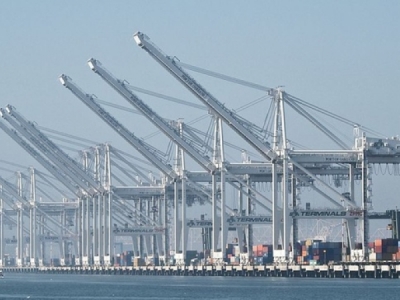
Posted on June 20, 2019
Dive Brief:
- The Port of Oakland plans to achieve zero-emissions operations over the next 30 years and this week released its 259-page plan for achieving that goal. It was developed over the course of 18 months “with community leaders, business representatives and academics,” according to a press release.
- The plan outlines multiple changes the port would need to undergo to make this a reality including converting fleet vehicles to electric power, continuing its conversion of cranes to hybrid power and persuading ocean carriers to switch from fuel power to plug-in land power when docked.
- “From our last plan 10 years ago, we reduced diesel emissions from trucks 98%, we’ve reduced emissions from ship 75%,” Port of Oakland’s Communication Director Mike Zampa told Supply Chain Dive. “So we’ve made significant progress, but especially in the area of ocean-going vessels, there’s more to do.”
Dive Insight:
The port’s last emissions plan went into place about a decade ago and will expire in 2020. This new plan, “Seaport Air Quality 2020 and Beyond Plan: The Pathway to Zero Emissions,” does not have an expiration date. That’s because it’s hard to put a timeline on when the goal of zero emissions will actually be achieved, according to Zampa.
“We’ve got a really broad vision, you know, move towards zero emissions, but nobody can really say when that can be done,” he said. “Technology isn’t in place to achieve that goal yet. Certainly, the funding isn’t there to get us to zero emissions yet. So there’s lots that has to happen.”
The port will revisit the plan every five years and has multiple phases in which it expects to complete various aspects of this effort. The “near-term phase” begins in 2019 and will last until 2023. During this time, the port will convert its rubber-tired gantry (RTG) cranes with hybrid motors, apply for grant funding, conduct an emissions inventory and purchase a 10-passenger electric van for the port’s fleet.
This process of converting the cranes’ power supply is already underway. The Oakland International Container Terminal is converting its 10 RTG cranes to hybrid power, which will reduce their emissions by 90%. There are also multiple electric vehicles already operating at the port, according to Zampa.
Ocean vessels are one of the big drivers of emissions at the port. When a container ship pulls into the port to load or unload goods, the emissions from that ship count toward the port’s emission count. The way to deal with this is to have the ships plug into an electric power source once they’re docked so they don’t have to rely on generating power from the ship’s fuel supply. But some of the older ships don’t have this ability,
“In 2020, [carriers] start using lower sulfur fuel as an IMO requirement,” he said. “So we’ll gain [an] advantage from that regulation.”
Oakland is not the only port moving toward zero emissions. The Ports of Los Angeles and Long Beach have plans to reach zero-emissions port equipment by 2030 and zero-emissions trucks by 2035. A recent feasibility study of these goals said the technology to make this a reality is either already available of will be in the near future (between 2018 and 2021).
The biggest hurdle for Oakland, Zampa said, is the cost associated with the transition.
“We’re doing fine financially, but it’s a big, big price tag to get towards zero emissions,” he said. “So it’s going to require partnership with our tenants and customers and others who want to invest here, and it’s going to require funding from regional state and federal sources, too.”
Source: supplychaindive.com





